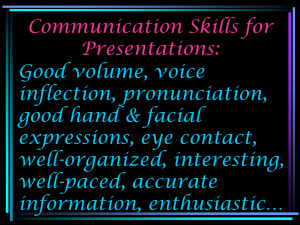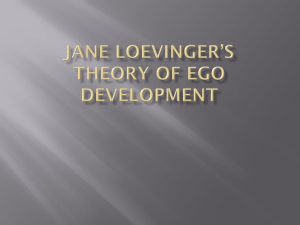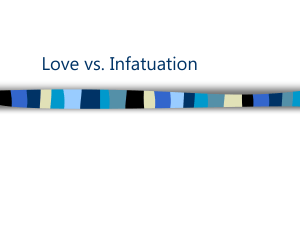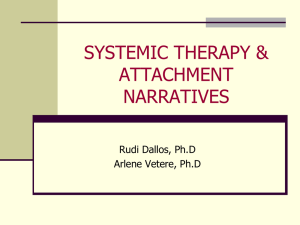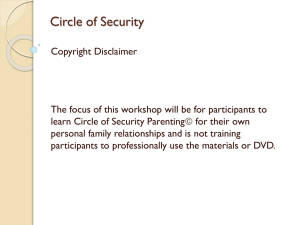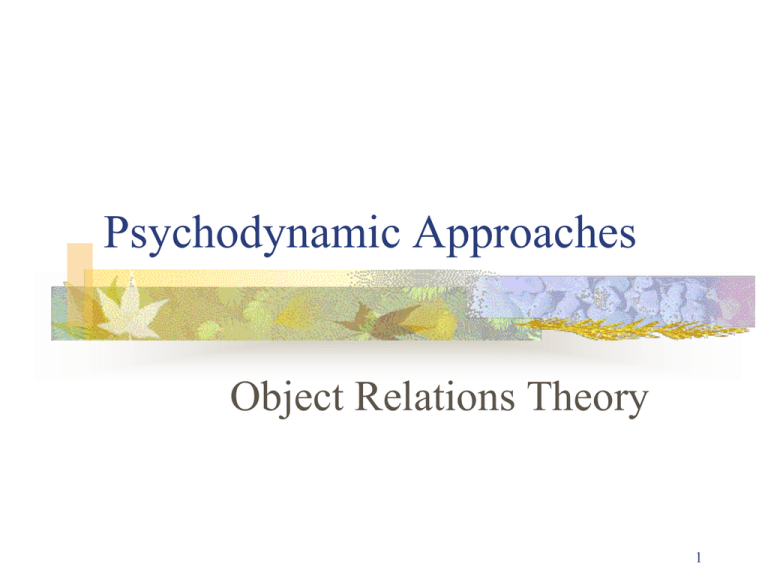
Psychodynamic Approaches
Object Relations Theory
1
Psychodynamic Approaches
Neo-Freudian Tradition
Alfred Adler, Wilhelm Reich, Carl Jung, Otto Rank,
and Sullivan
Ego-Analytic Tradition
Self-Psychology and Object Relations Theories
Originated with Anna Freud and Melanie Klein’s
observation of infants in the 1930’sd 1940’s
Winicott, Erikson, Mahler, Fairbarn
2
Neo-Freudian Tradition
Objected to Freud’s emphasis on instinct theory,
infantile sexuality and his view of the Oedipus
complex
More concerned than Freud with:
The nature of conscious experience: cognition and
will – human’s ability to choose
Psychological health and normal development
Socio-cultural determinants of behavior
External sources of conflict
3
Ego-Analytic Tradition
Based on work with young children and
severely disturbed adults
Emphasizes Ego’s functioning in adaptation,
coping, and mastery unrelated to instinctual
forces
Development of self and psychological
characteristics are explained in terms of the
internalization of psychosocial experiences
Views personality and motivation in terms of
interpersonal transactions and not instincts
4
Psychodynamic Approaches
Agree with Freud in
The importance of early life
The importance of the unconscious
The role of defense mechanisms
The use of transference, counter transference,
interpretation, insight, resistance and catharsis in
therapy
Abandon the couch and pay attention to the
therapeutic alliance based on a real therapist –
client relationship.
5
Object Relations Theory
1.
2.
3.
4.
Concerned with the formation of the self
before the Oedipal stage
Major drive of humans is the drive to
relate
Ego’s role is to seek relationships rather
than to control an unruly ID (Fairbarn)
The self is formed in the context of early
relationships
6
Objects
Object Relations
External Objects
Interpersonal relations
Significant persons that are the target of a
person’s feelings, desires, needs
Internal Objects
Internalized images of the external person,
which may differ from the real person
7
Psychological Function of Infants
Splitting (normal and defensive process)
Keeping apart contradictory feelings about othersgood mother vs. frustrating mother
Internalization of “Others”– “Experiences”
An aspect of the external world* is introjected and
becomes part of the child’s internal world
*Emotional experiences & characteristics of relationships
Internal objects carry out functions performed by the
external object: trust, self-worth, condemnation.
Lead to the formation of self-representations
8
Self-Representations
How the infant perceives him/herself in relation
to significant others in their lives
Initially, external objects and self are not
differentiated
Pleasurable feelings are internalized as “good me”
Frustration is internalized as “bad me” which is
painful – and often repressed
Self-representations and internalized objects
shape how one relates to others in the world
9
Inner and Outer World of Objects
10
Development of the Self
Crucial early development task : move from
a state of fusion and dependence on caregiver to
a state of increased independence and
differentiation (attachment-individuation
processes)
Adequate, positive relations in the early stages
lead to good feelings about self
Disruptions leave the child feeling empty,
deficient, frustrated
11
Development of the Self - Mahler
Normal Autism First 3 to 4 weeks
Objectless period of primary narcissism
Responses based on physiological tensions
Normal Symbiosis 2-3 to 8 months
Dim awareness of mother as separate
Differentiates pleasurable (bliss, reaching out)
from frustrating experiences (aggression)
Investment in the relationship with
caretaker is the crucial point from which all
subsequent relationships form
12
Harry Harlow: On the Nature of Love –
American Psychologist -- 1958
13
Harry
Harlow
After 8 months of total isolation, damage to the ability to form bonds
was permanent
Less than 3 months, damage was reversible
Food, cuddling, warmth, movement and few hours of play
Development of the Self - Mahler
Separation Individuation 10 months to 21/2 years
“No” period - disengagement from symbiotic
relationship – emergence of the Ego
Caretaker: balance between letting go and being
emotionally available
Neglect or enmeshment will hamper exploration of
environment.
Neglect: child will focus energy on getting attention
May revert to earlier splitting mechanisms that
may lead to narcissistic or borderline disorders
15
Attachment -- Autonomy
16
Development of the Self - Mahler
Emotional Object Constancy and Individuality
3 years old on
Internalization of a positive image of caretaker
comforts child in caretaker’s absence and
allows for individuation
Ability integrate “good” and “bad” aspects of the
internalized object (caretaker)
Development of a unified self-image: cohesive self
Development of complex cognitive functions & language
Increased reality testing and curbing of aggressive feelings
17
Psychopathology
Deficits in the early relations:
Generate feelings of aggression and anger
Hinder the development of a cohesive self
Result in disintegrated internalized objects or
psychic structures- splitting
May lead to serious difficulties in adult
relationships:
Narcissistic Personality Disorder
Borderline Personality Disorder
18
Narcissistic Personality Disorder
Grandiose sense of self-importance
Preoccupied with fantasies of unlimited success, power,
brilliance, beauty, or ideal love
Believes that he or she is “special” and unique
Requires excessive admiration, praise
Has a very strong sense of entitlement, e.g., unreasonable
expectations or automatic compliance with expectations
Exploitative of others -- hostility
Lacks empathy
Often envious of others or believes others are envious of them
Regularly shows arrogant, haughty behaviors or attitudes
19
Borderline Personality Disorder
Frantic efforts to avoid real or imagined abandonment
A pattern of unstable and intense interpersonal relationships
extremes idealization and devaluation
Identity disturbance, unstable self-image or sense of self
Impulsivity in at least two areas (e.g., spending, sex, substance
abuse, reckless driving, binge eating)
Recurrent suicidal behavior, threats, or self-mutilating beh.
Emotional instability due to significant reactivity of mood
Chronic feelings of emptiness
Inappropriate, intense anger or difficulty controlling anger
Transient, stress-related paranoid thoughts or severe dissociative
symptoms
20
Therapy
Enable client to re-experience early stages
of development:
Explore repressed negative experiences
Cognitively
and emotionally
Explore how current conflicts repeat patterns
of behaviors and feelings about self and
others established earlier – including in
relation with therapist –
21
Therapy (continued)
and achieve a more positive level of
functioning (object relations):
The therapist provides some of the functions
that client lacked in childhood
Therapist serves as an auxiliary ego to help client cope with
painful, overwhelming emotions
Foster process of integration and synthesis of
self
22
Case Conceptualization: Richard
1.
Examine Richard’s current and early relationships
as they relate to issues of attachment and
autonomy.
2.
Describe ideas and feelings about self that Richard
might have developed during his upbringing
3.
Discuss how ideas and feelings about self may
influence Richard’s current problems; identify
patterns (adaptive or maladaptive) from early
relationships that Richard may be repeating in
current life.
Case Conceptualization: Richard
4.
Describe counseling goals: changes in
Richard’s feelings and/or behaviors
5.
Describe specific interventions
Ainsworth Strange Situation Research
Laboratory procedure used to assess infant attachment style. (Connell &
Goldsmith, 1982; Ainsworth, Blehar, Waters, & Wall, 1978)
1.
2.
3.
4.
5.
6.
7.
8.
Mother and baby introduced into room
Mother and baby alone, baby free to explore (3 minutes)
Stranger enters, sits down, talks to mother and then tries to engage the
baby in play (3 minutes)
Mother leaves. Stranger and baby alone (up to 3 minutes)
First reunion. Mother returns and stranger leaves unobtrusively. Mother
settles baby if necessary, and tries to withdraw to her chair (3 minutes)
Mother leaves. Baby alone (up to 3 minutes)
Stranger returns and tries to settle the baby if necessary, and then
withdraw to her chair (up to 3 minutes)
Second reunion. Mother returns and stranger leaves
unobtrusively. Mother settles baby and tries to withdraw to her chair (3
minutes)
25
Two aspects of the child's behavior are
observed:
The amount of exploration (e.g. playing
with new toys) the child engages in
throughout, and
The child's reactions to the departure and
return of its caregiver (mother)
26
Insecure-avoidant attachment
Child’s Behavior
(22% in original study)
Child will avoid or ignore the mother - showing little emotion when the
mother departs or returns.
Will not explore very much regardless of who is there. Strangers will
not be treated much differently from the mother.
Avoided the stranger, but not as strongly as they avoided the mother on
her return
There is not much emotional range displayed regardless of who is in
the room or if it is empty.
This attachment style develops from a mothering style which is more
disengaged. The child's needs are frequently not met and the child comes to
believe that communication of needs has no influence on the mother.
27
Insecure-ambivalent attachment
Child’s Behavior
(12% in original study)
Child is anxious of exploration and of strangers, even when the mother
is present.
When the mother departs, the child is extremely distressed.
Child will be ambivalent when mother returns, seeking to remain close
to the mother but resentful, and also resistant when the mother initiates
attention. Child may scream and rage, rather than be pacified when the
mother returns.
Child shows ambivalent behavior towards the stranger, similar to the
pattern of resistance and interest shown to the mother
This style develops from a mothering style which is engaged but on
the mother's own terms. That is, sometimes the child's needs are
ignored until some other activity is completed; attention is sometimes
given to the child but more to meet the parents’ needs than from the
child's initiation.
28
Secure attachment
Child’s Behavior (66% in original study)
This style represents a balance between overinvolvement with the environment or with the
mother.
Child explores freely while the mother is present,
Child shows moderate avoidance of the stranger,
although is friendly when the mother is present.
is visibly upset when the mother departs, and
is happy to see the mother return.
29
Attachment in intimate relationships
Securely attached people are able to place trust in their partner
which, in turn, means they can confidently spend time apart.
People with an anxious ambivalent attachment style may have
difficulties because their way of behaving in relationships can be seen
as needy or clingy by their partner. They are prone to worry about
whether their partner loves them or whether they are valued by their
partner.
People with an avoidant attachment style are uncomfortable being
close to others. They have difficulties in trusting other people and do
not like to depend on others.
Such patterns are believed to be working models that develop in
infancy, but can be modified as people enter into new relationships.
Phillip Shaver, Cindy Hazan, and others
30

